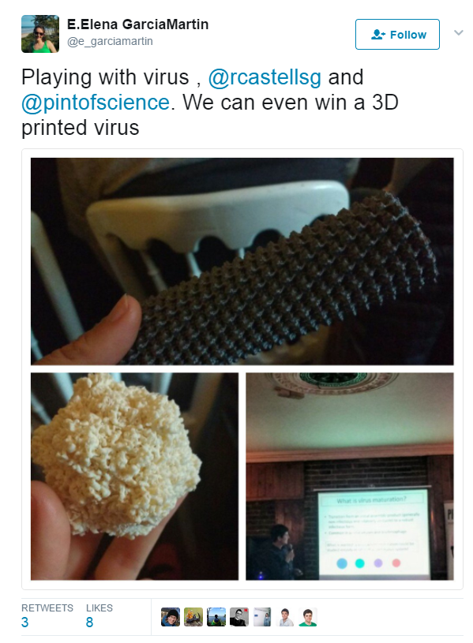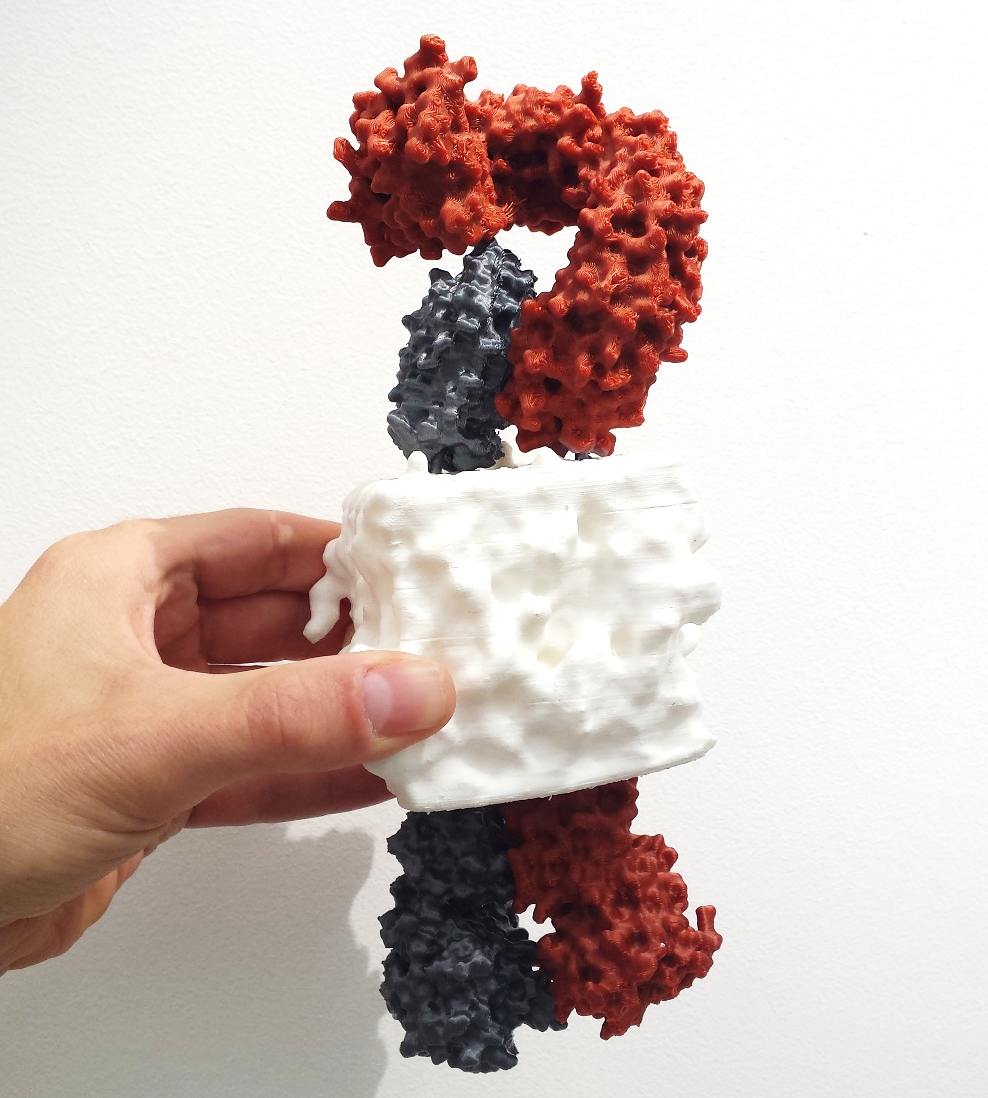Accessible 3D Models of Molecules
Creating 3D printed models of biological molecules for teaching and outreach.
The Idea
This project aims to create kits of 3D models of molecules for schools and outreach activities. The models will be used to facilitate the understanding of viral structures, polymers and synthetic biology projects. The kits will include complete structures and also pieces to be assembled as 3D puzzles and will be a tool for teachers and researchers to teach about their subject in an interactive manner.
The Team
Mr Roger Castells Graells,
Graduate student, Biological Chemistry, John Innes Centre, Norwich
Ms Vanessa Bueno,
Graduate student, Crop Genetics, John Innes Centre, Norwich
Ms Elisabeth Gill,
Graduate student, Department of Engineering, University of Cambridge
Project Outputs
Project Report
Summary of the project's achievements and future plans
Project Proposal
Original proposal and application
Project Resources
For more information, see Roger's Youtube video about his work, and blog post about the success of this OpenPlant Fund project.
Accessible 3D Models of Molecules, the start of a global project
Summary
This project aims to create kits of 3D models of molecules for schools, outreach activities and scientific events. These models are used to facilitate the understanding of viral structures, polymers and synthetic biology projects. The models include structures and also pieces to be assembled as 3D puzzles and will be a tool for teachers and researchers to teach about their subject in an interactive manner.
The project has exceeded all the initial expectations. 3D printed models of viruses have been distributed among scientists and teachers from UK, Germany, Spain, Jordan and Kenya. In three months, the 3D printed models produced with this project have already reached people from three continents and the previsions are that it will continue expanding in the following months. We are receiving requests from scientists and teachers to produce more models that include, for example, viruses, proteins, nanoparticles, self-assembly models and bacteria.
Report and outcomes
With this project we have managed to set up a 3D printer and we have started printing 3D models already available in databases. Furthermore, we have generated new 3D printing models of viruses and proteins using structures of interest from databases with 3D shapes of proteins and macromolecular complexes (PDB and EMDB).
To generate the new 3D printing files we have used UCSF Chimera, Autodesk Netfabb Standard 2017, Cura and Prusa3D Slic3r.
There is available online a really useful guide: “Eduardo’s Guide for 3D Printing Proteins” (http://www.munfred.com/proteins.html), that describes how to use Chimera to generate 3D printable molecular models
To print the models we have used PLA (Polylactic acid) thermoplastic filament because it is a biodegradable and very strong material. It does not produce chemical odours during printing and there is a big range of colours available. So far, 3D printed models are made usually of a single colour. However, we plan to upgrade the printer in order to be able to print using four colours at the same time. This will open a whole range of opportunities in the design of new models since it will be possible to highlight specific parts of the models and distinguish different subunits that form the macromolecular complexes.
Several of our 3D printed models of viruses.
The opportunity for scientists and teachers to have these 3D models is unique as it offers an invaluable tool that is having a huge impact in education and communication. The 3D models can be used in high school, where students can learn about the different shapes, sizes, structures and functions of viruses. Furthermore, they can be used to relate biological concepts with mathematics as some viruses follow mathematical patterns. For university teachers, it offers the possibility to talk in more detail about the structure of the viruses and make them more accessible. In outreach events it gives the public the chance to see, for some of them as the first time, the structure of molecules that are usually invisible and unknown for them. Viruses and proteins are in the scale of angstroms (10-10 metres) or nanometres (10-9 metres), therefore they are usually inaccessible for the general public. For scientists it is also a great tool to share their research with other scientists in more detail and in a more accessible way. These 3D printed models have already been used in outreach events, scientific meetings and international conferences.
The delivery of the 3D printer was delayed until April, therefore, the project has been developed mainly between April and June and just a fraction of the initial budget has been used. Furthermore, the process of getting familiar with the 3D printer and the programmes to generate the models have also taken quite a bit of time. Now that the 3D printer is stablished and that we have more knowledge in the use of the programmes, there is a possibility to increase the scope of the project.
Public engagement activities where the 3D printed models have been used
Tweets about the Pint of Science event.
Pint of Science Festival - Medicinal Viruses: From Foe To Friend (16th May 2017):
Prof. George Lomonossoff and Roger Castells-Graells participated at the Pint of Science Festival in Norwich, with talks about viruses. The title of George’s talk was: “Just Eat Your Greens - A New Way of Vaccinating?”. The title of Roger’s talk was: “20,000 Leagues Under the Microscope: Viruses & Nanomachines” and the description: “Why is it important to understand the structure of viruses? How can viruses help us to build nanomachines? Can research and viruses fight diseases? Travel with us to the amazing nanoworld of viruses and discover how scientists are using them to build knowledge and new tools.”
At the event, several models of 3D printed viruses were distributed around and the public loved having the opportunity to interact with them. It was a great experience and we received really positive feedback. Furthermore, a contest was organized by the Pint of Science team, where the public had to build a virus model using stationery materials. The winner received a 3D printed model of a virus. Overall, the attendants enjoyed and valued the opportunity to be able to play with structures of viruses and it was shared in Twitter.
3D printed virus models in Pia High School (Terrassa, Spain):
Roger presented some of the virus models in a high school with students aged 12 to 16 years old. The students enjoyed being able to handle and compare representations of real virus structures and were amazed that some of these structures were only discovered this year. When the school teacher was asked about how the use of educational 3D models in the classroom could benefit the learning process he answered that first of all it creates excitement and focuses the attention of the students. It is something completely new! It contributes to the understanding of three-dimensional models and gives the students a better sense of the reality of the object. Furthermore, it allows the students to calculate scale as it is possible to touch, measure and compare different models.
Amgen Biotech Experience talks: Scientific Discovery for the Classroom (22-23 June 2017):
Roger did two talks for school teachers in order to give them new concepts and ideas to share with their students. He highlighted what the Amgen Scholars programme is and he talked about his current research work in the lab of Prof. George Lomonossoff at JIC. The talks included reference to some of the techniques used in the lab that the teachers were learning during the sessions. Furthermore, Roger showed some of the paper and 3D printed models of viruses and explained how they can be used as an educational tool in schools.
3D printed models distributed among scientists and teachers around the world:
3D printed models of viruses have been distributed among scientists and teachers from UK, Germany, Spain, Jordan and Kenya.
Map highlighting the countries where the Accessible 3D Molecular Models have arrived.
3D printed models build in collaboration with other scientists:
In collaboration with Sebastian Pfeilmeier, PhD student, we printed the protein domains of a cell surface-localized pattern recognition receptor (PRR) complex that recognizes pathogen-associated molecular patterns (PAMPs). See the model in the following image.
Video materials where the 3D printed models have been used:
In this video, Roger explains the process followed in the lab of Prof. George Lomonossoff to produce virus-like particles in plants. At the start of the presentation, he uses some 3D printed virus models in order to introduce the concept of virus.
Blog post: My OpenPlant Experience: Outreach, Engagement and 3D printing
https://www.openplant.org/blog/2017/6/6/my-openplant-experience-outreach-engagement-and-3d-printing
Scientific events where the 3D printed models have been used
NRP Industrial Biotechnology Alliance meeting “Decoding and Recoding Biological Systems” (Earhlam Institute, Norwich, UK, 19 May 2017). Prof. George Lomonossoff presented some of the 3D printed models of viruses in his talk.
American Society for Virology - 2017 Annual Meeting (University of Wisconsin, Madison, USA, June 24-28). A picture of a 3D printed model of a geminivirus was presented by Dr. Keith Saunders (JIC).
NanoBioMater 2017 International Conference (University of Stuttgart, Bad Herrenalb, Germany, 28-30 June 2017). Roger presented a 3D printed model of NωV virus during his talk at the international conference.
NanoBioMater 2017 Summer School & International Conference (University of Stuttgart, Bad Herrenalb, Germany, 27-30 June 2017). Roger presented several 3D printed models of viruses during his poster presentations at the summer school and international conference.
SRUK/CERU V International Symposium (London, UK, 7th-9th July 2017). Symposium from the Society of Spanish Researchers in the United Kingdom. Roger gave a short talk and presented a poster where he used some 3D printed models of viruses.
Awards that involved the use of 3D printed models
In June 2017, Roger received an UEA Engagement Student Award for outstanding contribution to Public & Community Engagement. Among the activities that Roger has developed and that have been considered for this award, there is the Accessible 3D Models of Molecules project.
30th June 2017, Roger received the 5th prize for the scientific poster: "Studying dynamic virus-like particles for potential bionanotechnological applications" at the NanoBioMater 2017 Summer School & International Conference - University of Stuttgart. During the presentation of the poster, he used 3D printed models of viruses in order to contribute to the explanations and focus on the structure of viruses.
9th July 2017, Roger received the Best Talk award at the V International Symposium SRUK/CERU. During the presentation of the poster, he used a 3D printed models of NωV virus in order to contribute to the explanations. The award was decided by a panel of experts in science communication who judged the presentation.
9th July 2017, Roger received the Best Poster award at the V International Symposium SRUK/CERU. During the presentation of the poster, he used 3D printed models of viruses in order to contribute to the explanations and focus on the structure of viruses. The poster was voted by the participants at the Symposium.









